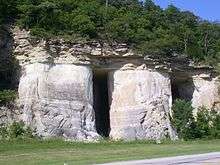St. Peter Sandstone

| Paleozoic Stratigraphy of the Upper Midwest, USA Dates are approximate, and deposition occurred at slightly different times in different areas |
|---|
| Ordovician
:Maquoketa Group (446–440 Ma)
:Galena Group (454–446 Ma)
:Knox Supergroup
:Knox Supergroup (ct'd)
|
The St. Peter Sandstone is an Ordovician formation in the Chazyan stage of the Champlainian series. This sandstone originated as a sheet of sand in clear, shallow water near the shore of a Paleozoic sea and consists of fine-to-medium-size, well-rounded quartz grains with frosted surfaces. The extent of the formation spans north-south from Minnesota to Arkansas and east-west from Illinois into Nebraska and South Dakota. The formation was named by Owen (1847)[1] after the Minnesota River, then known as the St. Peter River. The type locality is at the confluence of the Mississippi and Minnesota Rivers near Fort Snelling, Minnesota.[2] In eastern Missouri the stone consists of quartz sand that is 99.44% silica.
Outcrop
In Minnesota, the soft St. Peter Sandstone can be observed at the bluffs of the Mississippi River valley beneath a very thin layer of Glenwood Shale, which lies below a much thicker layer of Platteville limestone.[3] Examples can be seen at Minnehaha Falls in Minneapolis, the bluffs from downtown to Mounds Park in Saint Paul, and Minneopa Falls near Mankato.
Commercial use
St. Peter sandstone, also called "Ottawa Sand" in commercial applications, has a relatively uniform size and shape for each grain. It is used for the manufacture of glass, for filter and molding sand, and for abrasives. Its purity is especially important to glassmakers. It is also important as a "frac sand" in oil and gas drilling – loose sand is pumped in a liquid mix under high pressure into a well where the sand grains wedge into and hold open any fractures in the rock, enhancing the extraction of hydrocarbons. The uniform particle size also makes the sand useful for laboratory experiments.
Mining locations
St. Peter sandstone is or has been mined
- Arkansas: Guion, Arkansas
- Illinois: Ottawa, Illinois, Sheridan, Illinois, Wedron, Illinois, and Naplate, Illinois
- Minnesota: Kasota, Minnesota and Ottawa Township, Minnesota
- Missouri: Pacific, Festus, Crystal City, Augusta, and Pevely
The Unimin corporation is a large producer of commercial sand and operates the surface mines in many of these locations.
Notes
- ↑ Owen, D.D., 1847, Preliminary report of the geological survey of Wisconsin and Iowa: U.S. Gen. Land Office Rept., 1847, p. 160-173.
- ↑ Stauffer, C. R., 1934, Type Paleozoic sections in the Minnesota Valley: Jour. Geology, v. 42, p. 337-357.
- ↑ Mossler, J. and Benson, S., 1995, 1999, 2006, Fossil Collecting in the Twin Cities Area. Minnesota at a Glance: Minnesota Geological Survey: University of Minnesota.
References
- Unklesbay, A.G; & Vineyard, Jerry D. (1992). Missouri Geology – Three Billion Years of Volcanoes, Seas, Sediments, and Erosion. University of Missouri Press. ISBN 0-8262-0836-3.
- Void ratio of sand Argonne National Laboratory, Division of Educational Program
- Twin Cities Geology - Mississippi National River and Recreation Area. National Park Service